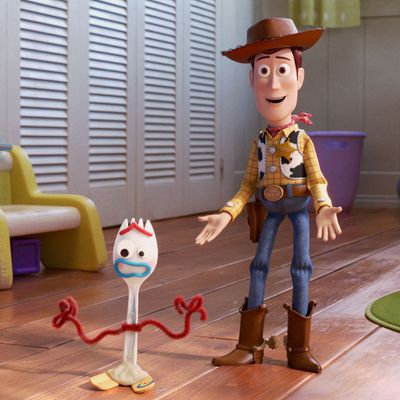
Call him Frankenstein’s Spork. The central figure in Toy Story 4 — not so much the protagonist but the character around whom most of the film turns — is a simple little plastic utensil that’s been outfitted with googly eyes and pipe-cleaner limbs by a lonely kindergartner. Oh, and contrary to all science and reason — even the perverse science and reason of the Toy Story universe — he’s sentient. After young Bonnie, the latest human owner of the series’ familiar coterie of talking toys, puts together this adorable monstrosity, the spork — christened Forky — opens his eyes and speaks! Unfortunately, all he can say at first is “Trash,” which is also all he wants: He longs to hop into the nearest garbage can, cuddle up with a napkin-blanket, and forget about the big scary world into which he’s just been born.
The bizarre, unsettling, and somehow still delightful Forky is the first sign that this Toy Story is not like the other Toy Story films. But he’s not the only sign, and more weirdness soon ensues. After Bonnie’s family loads up an RV and goes a road trip, Forky throws himself from a window of their moving vehicle and into the night. Determined to protect Forky at all costs, our rag-doll-cowboy hero Woody (voiced by Tom Hanks) heads out in pursuit. Woody soon finds himself in an antique shop presided over by Gabby Gabby, an immaculately coiffed and made-up talking doll who is accompanied at all times by an honor guard of terrifying, loose-necked ventriloquist’s dummies. But for all her surface polish, Gabby is secretly a defective product with deep reserves of inadequacy; she’s perched somewhere between a figure of pathos and Stepford Child. To her, a world in which a misshapen utensil gets love while a seemingly perfect vintage doll languishes in dusty loneliness and rage is an unfair one.
Seriously, did David Lynch write this thing?
Such twisted developments in a Pixar sequel are more than welcome nowadays, since the once-mighty animation studio seems so content to churn out somewhat predictable, turbo-loaded follow-ups to its classics. What makes Toy Story 4 work is that instead of providing us with a clear emotional map to its characters and themes, the film never quite lets us know what to feel. It’s an unnerving little movie, one that at any given moment might deliver a burst of feeling, or a big laugh, or a jump scare. It whipsaws you this way and that, and this sense of disorientation is new for a company whose work usually feels so carefully calibrated, so perfectly put-together.
In that sense, Toy Story 4 perhaps embodies its own message. It feels like a movie eager to break out of a mold — any mold. Every character in the movie struggles with a longing for a status quo that no longer exists. Woody thinks he can continue to be his child’s essential toy; indeed, the reason he’s so protective of Forky is because it makes him feel relevant. Bonnie herself is terrified of kindergarten and being separated from her parents. We’re all Forkys at heart, the film seems to be saying. And by breaking out of the cozy boundaries of the Toy Story films, it lights out for new, uncertain territory.
That’s not to say that this isn’t still Pixar. I won’t give away the film’s climax, but I will say that the inevitable tears are jerked in layers: There’s one emotional climax for those viewers who are new to the series, another for those who have only vague memories of the previous films, and yet another for those who’ve totally grown up on these pictures. It’s a generous, inclusive approach, an acknowledgment that each person sees a different movie. Toy Story 4 is messy but in the best possible way.


